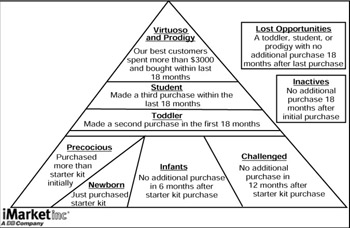Automatic Trigger Marketing
|
IMarket, a D&B company, sells data to companies that want to get business leads and learn more about their existing customers. IMarket initially delivered data on a CD-ROM (CD) with a meter attachment for the user’s PC that permitted the user to select records from the CD for a given price per name. To use the system, companies had to install the CD and register with iMarket.
The arrival of the Internet gave iMarket a new channel for delivering product—by the Web rather than by a CD. Zapdata.com, iMarket’s Internet product, provided a much wider market for the company’s product. However, Zapdata.com required the company to develop new marketing strategies to acquire, retain, and cross-sell products through both the Internet and the desktop.
IMarket’s objectives were twofold:
-
To create a database that would provide a complete view of iMarket’s customers and prospects, both those using the desktop and those using the Web.
-
Set up a one-to-one automated marketing program that would enable the company to understand past behavior and the response to past promotions, and to gather new information through the Web.
These objectives had to take into account the fact that iMarket was a small company with limited in-house resources. Therefore, iMarket created an in-house customer and lead information database that was segmented using
-
RFM analysis
-
Logistic regressions based on business demographics
-
Software that permitted the merging of records from different units of the same companies and the elimination of duplications from those records
The resulting segmentation system was used to create 10 meaningful RFM segments: Virtuoso, Prodigy, Student, Toddler, Precocious, Challenged, Infants, Newborn, Lost Opportunities, and Inactives. These segments are shown in Figure 10-1.

Figure 10-1: iMarket Prospect Segmentation System
Automated marketing programs were set up to move customers into higher-value buying segments. The programs consisted of a large number of dialogs, which were directed and monitored by Revenio’s Dialog software. A sample report is shown in Table 10-10.
| Conversations | Messages | ||||
|---|---|---|---|---|---|
| Total | Active | Sent | Opened | Responses to questions | |
| Zap registrant surveys | 5516 | 792 | 15 | 5 | 3 |
| Zap registrant nonbuyers | 300 | 207 | 209 | 50 | 10 |
| Buyers invited to training | 430 | 170 | 123 | 0 | 0 |
| CSR survey | 2195 | 142 | 772 | 368 | 149 |
| Corporate billing contract usage | 137 | 14 | 147 | 0 | 0 |
The database provided the sales force automation software with lists of customers and prospects to contact, indicating the segment they were in as well as demographics and model scores and the prior history of all calls and contacts. The communications included a variety of different messages, such as:
-
Welcome letter
-
Welcome call
-
Training fax
-
Customer support survey
-
Meter credit promotion
-
Renewal fax
-
Nonrenewal fax
-
Upgrade promotions
-
Inactive revival
-
No-contact call
IMarket set up automated trigger marketing campaigns for the contacts in its database. These contacts had “raised their hands” by attending one of the company’s seminars, registering at the company’s Web site, responding to an ad, or visiting iMarket’s booth at a trade show. Once they are in the database, the company markets to both leads and customers through phone, fax, and email. Customers can choose their preferred delivery medium.
The new database program was used to
-
Eliminate duplicate records of customers and leads
-
Mailing costs were lowered.
-
Customers were no longer treated as leads.
-
Different salespeople were no longer assigned the same companies.
-
Fights between salespeople over leads were reduced, and commission payments were lower.
-
The entire company had increased confidence in the quality of the data.
-
-
Have a unified view of customers across online and offline channels
-
There was a better understanding of customers’ needs.
-
The sales force was now able to view the customer’s entire history and sell more confidently.
-
Cross-selling opportunities increased.
-
Unified company reporting became available.
-
-
Create automated marketing programs
-
Batch marketing was replaced by messages triggered by customer buying behavior.
-
The “traffic cop” feature prevented customers from receiving different messages at the same time.
-
Instead of being based on the marketing department’s timetable, programs were based on customers’ buying and demographic characteristics.
-
The number of programs run was no longer based on the number of marketers available, since the technology could add new programs easily.
-
As a result of the new system, iMarket
-
Increased its revenue by 50 percent per quarter and increased the value per customer by 35 percent per quarter for seven quarters in a row.
-
Decreased the cost of customer acquisition by 30 percent per quarter over seven quarters.
-
Reduced the marketing staff while creating 17 new programs that were executed daily.
|
EAN: 2147483647
Pages: 226